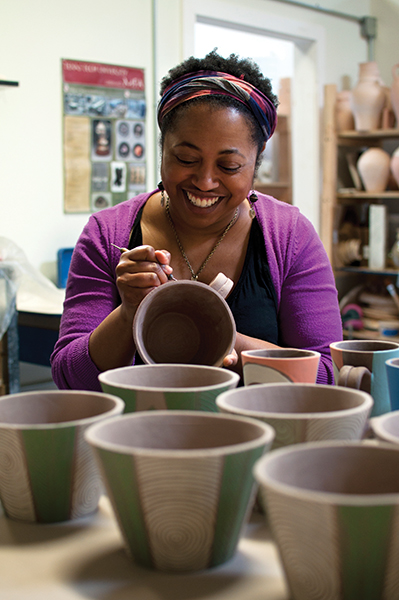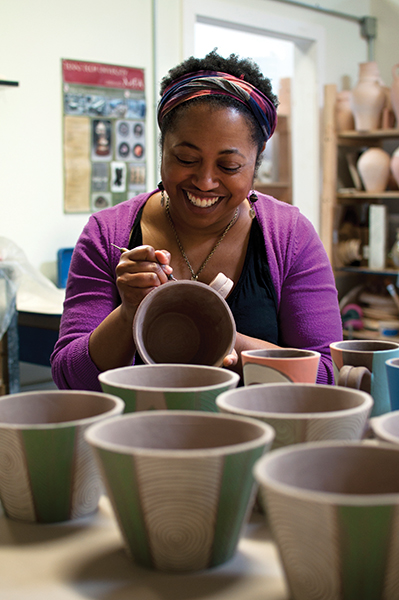Unbreakable
by Marilyn Anthony
Life-threatening health issues. Gun violence. Racism. All of them could have molded ceramic artist Stefani Threet into a very different person. But at every turn of fate’s wheel, she countered her challenges: with strong ties to family, friends and other potters, her love of nature and with her talent and positive energy—the last of which comes beaming through in what her mother Jacqui Simmons calls her daughter’s “Cherry Kool-Aid smile.”
Over the last three decades, Threet has managed to grow from a sickly kid interested in art into an established artist. During the recent Picasso exhibit at the Barnes Foundation, her mastery of sgraffito, a freehand method of carving fine lines into clay, was on display in her distinctive platters, mugs and bowls in the museum gift shop.
While she says that “silence and nothingness” inspire her organic patterns of swirling concentric circles, she often listens to world music while working, and also has what she calls her “Beyoncé and Bruno Mars days” to keep her energy up. She spends at least 40 hours weekly in the West Philadelphia Cedar Works studio space she shares with 11 other potters.
Happily listening to music while she works has come after a series of hardships that would have broken many people.
“My story,” says Threet, “is about overcoming adversity. I’m 36 now, and I’m where I thought I’d be in my 20s. It’s been a long journey getting here.”
Challenges came early. The youngest of three siblings, Threet was ill so often that Simmons recalls “living” at Children’s Hospital. In 1988, at 8 years old, Threet and her family were devastated when they lost her 15-year-old brother to gun violence.
There were positives: An early private school education exposed Threet to arts and culture. But when her parents separated, she had to transfer to public school in West Philadelphia, and there she stood out as “the kid who spoke too proper and was interested in weird things,” says Threet. Her mother tirelessly sought out enrichment programs to provide more than the neighborhood streets offered, waiting hours in pouring rain to enroll her daughter in the Fleisher Art Memorial programs and spending Saturdays trekking across town on SEPTA for the free art classes.
When Threet was 15, her essay for the Academy of Natural Sciences Women in Natural Sciences program won her a life-changing trip to Belize. Threet describes crawling into holes in the ground that opened up into caverns with “humongous pots stuck into the wall.” These ancient Mayan pots left a lasting impression.
Threet, the first person in her family to attend college, chose to study ceramics at Alfred University. She’s also lived in Mexico—where, she says, after much black and white ceramics work, “my world became colorful.” She’s also spent time in Seattle and at Arrowmont School of Arts and Crafts in Tennessee, where she encountered influential potters Sana Musasama, Margaret Bohls and Philadelphia potters Sandi Pierantozzi and Neil Patterson.
As Threet recalls, Pierantozzi and Patterson saw the need for more African-American artists teaching at the college level and encouraged Threet to return to Alfred. She did, but soon chafed at Alfred’s lack of diversity, receiving her degree but deciding against an academic career.
She returned to Philadelphia, in order to care for her parents, who were now located on two different coasts. Her father passed away, and a new round of setbacks hit. Threet recalls 2014 as a “rock-bottom year.” That June, she had major surgery. In August she was laid off from her job as a Mural Arts teaching artist working with marginalized youth. In October, a cab struck her, leaving Threet barely able to walk. Months of intense physical therapy, shiatsu massage and support from her mother and boyfriend restored her health.
Threet decided this was her moment to pursue pottery full-time.
Despite her many challenges, Threet identifies one in particular that held her back. “I always felt that the only thing standing between me and doing [pottery] full-time was finances,” she says. A loan from a friend enabled her to apply to higher caliber craft shows, and in 2015 she threw herself into a grueling April-to-December production schedule, selling pots at over 40 shows across the mid-Atlantic region.
This broad exposure brought the lack of diversity in the craft world into focus again for Threet.
“I’m very much aware that in the craft market circuit I am one of a few—if not the only—person of color. For some reason I have been able to break some of those racial barriers… My mom fought very hard for racial equality, and she’s taught me a lot. For my own progression, I’ve sort of silenced that voice…if I listened to it a little bit too loud then I wouldn’t be able to do the things that I am doing.”
Her mother is still her biggest champion, but her perseverance, talent and willingness to give back have earned her widespread respect. Multimedia artist and mentor Leroy Johnson, 78, who remembers being “the lone black ranger” in the arts and crafts scene, calls her “a role model for young craftspeople.” Hope Heffner, a former student of Threet’s, agrees with Johnson.
“[Stefani] loves her craft, not to further her own agenda, but to help the community,” she says. “She wants to help other people to connect and find art as a way to enhance life.”








